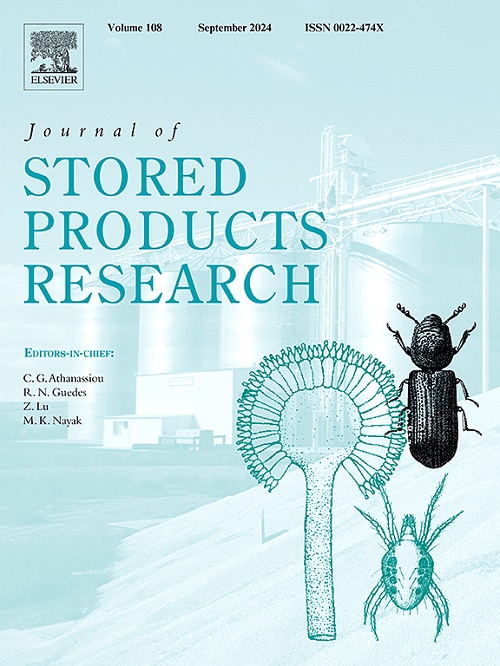香芹酚对辣椒采后品质、抗氧化系统及挥发性物质代谢的影响
IF 2.7
2区 农林科学
Q1 ENTOMOLOGY
引用次数: 0
摘要
观察到辣椒采后水分流失和皱缩品质下降,其挥发性化合物的变化值得进一步研究。本研究采用联合转录组和GC-MS/LC-MS分析方法研究了香芹醇处理对收获后辣椒抗氧化类黄酮和挥发性物质代谢的影响。结果表明,0.015 mg mL−1浓度的香芹醇能有效延缓采后辣椒硬度、可滴定酸度、辣椒素含量、总酚类化合物和总黄酮的下降,同时还能减缓采后辣椒失重、相对电导率和腐烂率的增加。本研究共鉴定出1304个差异基因,其中143个差异基因与类黄酮代谢有关。香芹酚增加了4-香豆酸-辅酶a连接酶(4CL)、查尔酮合成酶(CHS)、类黄酮合成酶(FNS)、udp -葡萄糖醛基转移酶(UGT)、转酮醇酶(TK)、氮酸脱氢酶(ADT)、1-脱氧-木醛糖-5-磷酸合成酶(DXS)、1-脱氧-d -木醛糖-5-磷酸还原异构酶(DXR)和异戊烯基磷酸激酶(IPK)基因的表达。香芹酚还下调了查尔酮-黄酮异构酶(CHI)、黄酮醇合成酶(FLS)和类黄酮3-羟化酶(F3H)的基因表达。此外,木脂素-7- o -新橙皮苷、山奈酚-3- o -芦丁苷和山奈酚-3- o -半乳糖苷的含量也有所增加。值得注意的是,收获后辣椒的72种差异挥发物在储存期间有所下降。贮藏40 d后,4-己烯-3-酮、(E)-2-己烯醛、2-呋喃甲醇、1-己醇、2-甲基-2-戊醛、Copaene、2-甲基丁酸、乙酸甲酯、异戊酸、(E)-2-甲基-2-丁醛和苯乙酸丙酯等特定挥发性香气化合物的含量有所上升。由此可见,香芹醇在维持采后关键挥发性香气物质含量的同时,影响了类黄酮代谢,从而对辣椒采后品质产生积极影响。本文章由计算机程序翻译,如有差异,请以英文原文为准。
Effect of carvacrol on postharvest quality, antioxidant system and volatile substance metabolism of peppers (Capsicum annuum L.)
Postharvest water loss and crumpling quality degradation in peppers were observed, and the changes in their volatile compounds warrant further investigation. This study examined the effects of carvacrol treatment on the metabolism of antioxidant flavonoids and volatile substances in post-harvest peppers using a combined transcriptome and GC-MS/LC-MS analysis. It has been demonstrated that carvacrol, at a concentration of 0.015 mg mL−1, effectively delayed the decline in hardness, titratable acidity, capsaicin content, total phenolic compounds, and total flavonoids, while also mitigating the increase in weight loss, relative electrical conductivity, and decay rate in post-harvest peppers A total of 1304 differential genes were identified by transcription in this study, of which 143 differential genes were involved in flavonoid metabolism. Carvacrol increased 4-coumarate-CoA ligase (4CL), chalcone synthase (CHS), flavonoid synthase (FNS), and UDP-glucuronosyltransferase (UGT), transketolase (TK), azelate dehydrogenase (ADT), 1-deoxy-xylulose-5-phosphate synthase (DXS), 1-deoxy-D-xylulose-5-phosphate reductoisomerase (DXR), and isopentenyl phosphate kinase (IPK) gene expression. Carvacrol also downregulated the gene expression of chalcone-flavanone isomerase (CHI), flavonol synthase (FLS) and flavonoid 3-hydroxylase (F3H). Additionally, it increased the content of lignan-7-O-neohesperidin, kaempferol-3-O-rutinoside, and kaempferol-3-O-galactoside. Notably, the 72 differential volatiles in post-harvest peppers decreased over the storage period. However, after 40 days of storage, the levels of specific volatile aroma compounds, including 4-Hexen-3-one, (E)-2-Hexenal, 2-Furanmethanol, 1-Hexanol, 2-Methyl-2-pentanal, Copaene, 2-Methylbutyric acid, Methyl acetate, isovaleric acid, (E)-2-Methyl-2-butyraldehyde, and Phenylacetic acid propyl ester was up-regulated. Thus, it is illustrated that carvacrol affects flavonoid metabolism while maintaining the content of key postharvest volatile aroma substances, thus positively influencing the postharvest quality of pepper.
求助全文
通过发布文献求助,成功后即可免费获取论文全文。
去求助
来源期刊
CiteScore
5.70
自引率
18.50%
发文量
112
审稿时长
45 days
期刊介绍:
The Journal of Stored Products Research provides an international medium for the publication of both reviews and original results from laboratory and field studies on the preservation and safety of stored products, notably food stocks, covering storage-related problems from the producer through the supply chain to the consumer. Stored products are characterised by having relatively low moisture content and include raw and semi-processed foods, animal feedstuffs, and a range of other durable items, including materials such as clothing or museum artefacts.

 求助内容:
求助内容: 应助结果提醒方式:
应助结果提醒方式:


